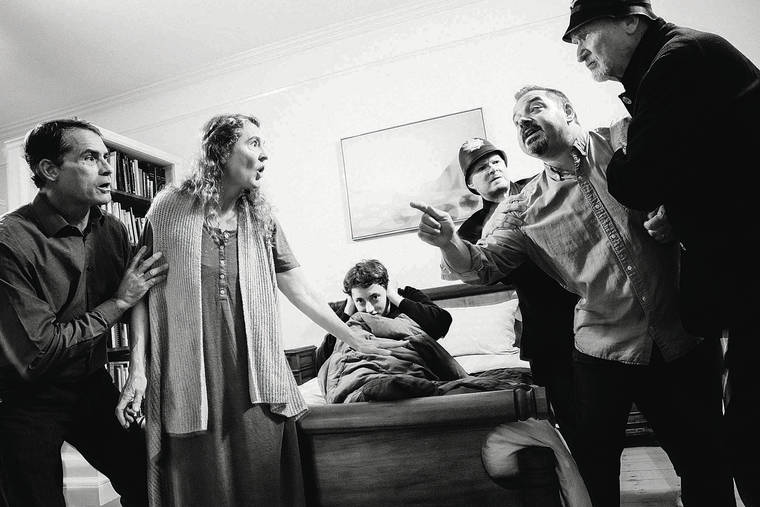When you’re putting on a show less than a decade after it won best new play, best director and best actor — first at the Olivier Awards in London and then at the Tony Awards, the Broadway equivalent — is it better to have seen the original or not to have seen it?
For the record, Mark Collmer, director of the ProArts Theater production of “The Curious Incident of the Dog in the Night-Time,” which opens Friday, has seen no more than a few clips of the much-honored Marianne Elliott production, enough to know that within what looked like an empty box, it packed more bells and whistles than you’ll find in a pinball arcade, and who could hope to compete with that?
Instead, Collmer, his creative team and his cast of 10 (six of them in multiple roles) have started with a clean slate, which is the right and proper thing to do.
As readers of Mark Haddon’s international bestseller and instant classic know, “The Curious Incident of the Dog in the Night-Time” presents itself as a murder mystery narrated by Christopher Boone, a special-needs 15-year-old who, just past midnight one night, discovers a neighbor’s poodle impaled on an upright garden fork. Briefly suspected of the crime, Christopher — a Sherlock Holmes fan — dons his figurative deerstalker to smoke out the killer, in the process turning on its head the world as he thinks he knows it.
That makes him a kind of latter-day Oedipus Rex, though in Christopher’s case there’s quite a lot of good news to counterbalance the catastrophes.
In the play, adapted by Simon Stephens, Christopher takes on the added duties of playwright, director and star of the show. He does so on assignment from Mrs. Gascoyne, the principal of his school, under the supervision of Siobhan, the paraprofessional who is his mentor. And he does so against his will.
“I don’t like acting,” he tells Siobhan in the play, “because it is pretending that something is real when it is not really real at all, so it is like a kind of lie.” And Christopher never lies. (Well, hardly ever.)
What exactly are we to make of Christopher? The flap copy for the first edition of Haddon’s novel, published in 2002, spelled out the answer: “Christopher John Francis Boone knows all the countries of the world and their capitals and every prime number up to 7,057. He relates well to animals but has no understanding of human emotions. He cannot stand to be touched. Though gifted with a superbly logical brain, Christopher is autistic.”
Like many another diagnostic label, this one has come under heavy political fire lately. Haddon has distanced himself from it on the grounds that he has no expertise in neurological and developmental disorders. His purpose, he has said, was to create a character.
By this he must have meant a unique personality, as opposed, that is, to some generic case study. Today, professionals and members of the affected community are at daggers drawn over the competing descriptors “neurodivergent” versus “neurologically divergent,” which may be a case of a distinction without a difference.
For what it’s worth, the neuropsychologist Rodger Meinz, who has consulted in well over 100 work-related cases involving Asperger’s syndrome, likens Christopher to Mr. Potato Head: “Rather than present a ‘real’ case of Asperger’s,” Meinz said recently, “Haddon has artificially constructed one that Nature would never assemble in reality.”
On the one hand, Christopher’s powers as a savant are no great shakes by clinical standards. On the other hand, Haddon subjects Christopher to emotional, social and logistical trials by fire a “real” Christopher could no sooner handle than he could walk on water.
Note taken. But isn’t this precisely the reason why people tell stories? To imagine things that aren’t so or might not be so? What matters, as Haddon has insisted, is the story: the classic fable of an underdog who defies all odds. Aspirational or inspirational? Take your pick.
Caro Walker’s set design for ProArts looks like a project in solid geometry, intuitively an apt metaphor for the structure of Christopher’s mind. A dozen white boxes with slanting tops, configured this way and that within one white giant box, allows a seamless flow of action from place to place, back and forth in time, and at one euphoric moment of fantasy even into outer space.
To convey Christopher’s blindness to facial expression, the six players of the ensemble wear white masks, forcing the audience to “read” them, as Christopher does, by other cues, like tone and body language.
THE SHOCK of experiencing the world through Christopher’s eyes surely accounts for much of his appeal, both in the book and on the stage. Few recent parts have been so challenging while at the same time so rewarding.
Though the London and New York productions of shows like “Billy Elliot” and “Matilda” cast the title roles with age-appropriate child actors who were also fiendishly accomplished, Christopher’s prize-winning originators in those theater capitals only looked Christopher’s age. Luke Treadaway, 28, came trailing a long string of major theater and film credits; his 25-year-old Broadway counterpart, Alex Sharp, arrived fresh from the rigorous drama division of the Juilliard School.
Their surprise successor at ProArts is Molly Oberg, who, like Christopher, actually is 15 years old and the owner of a beloved rodent.
“When the ProArts auditions were announced,” Collmer says, “Molly sent an email to Lin McEwan, our executive director, asking if she could try out for Christopher and bring Miss Daisy, her pet rat.” Oberg may also have mentioned that “The Curious Incident of the Dog in the Night-Time” is her favorite book.
Though permission was granted, the part wasn’t exactly hers to lose. For one thing, based on his knowledge of the local talent pool, Collmer already had two other contenders in mind. As it happened, neither of them was available. Even so, in the end, Oberg was up against three potential Christophers: one cocky, one frisky, one nonchalant, each with his distinct appeal.
Which in itself may have proved their collective Achilles heel. Christopher doesn’t appeal. He doesn’t connect. He inhabits a world apart. At callbacks, Oberg alone conveyed that condition of isolation. Opaque, stubborn, vaguely robotic, she slipped into Christopher’s skin without even seeming to try. And on a viewer’s part, it took no great act of imagination to “read” her as a boy.
In the meantime the journey of rehearsals has been taking her further. At the first run-through, several weeks later, Oberg seemed here and there to be channeling Christopher even when out of character. When a scene partner misremembered a picky detail of the stage business, she matter-of-factly set her straight, just as Christopher does with other players elsewhere in the script.
It was telling, too, that, as often as not, Oberg phrased questions less like questions than blunt statements of fact.
In usual parlance, the notion of dramatic illusion describes the players’ power to make the spectator suspend disbelief. But what about when an actor begins to merge with a character? Surely, that’s a kind of dramatic illusion, too. If so, could that be what Oberg is creating?
When the paying customers arrive, we shall see what we shall see.
—
‘THE CURIOUS INCIDENT OF THE DOG IN THE NIGHT-TIME’
>> Where: ProArts Playhouse, 1280 S. Kihei Road
>> When: 7:30 p.m. Thursdays to Saturdays, 3 p.m. Sundays, Wednesday to Jan. 26
>> Cost: $27
>> Info: 463-6550 or proartsmaui.com Opens in a new tab
Matthew Gurewitsch comes to Hawaii from three decades in New York as a cultural commentator for The New York Times, the Wall Street Journal and other media. Browse his archive at beyondcriticism.com Opens in a new tab.




